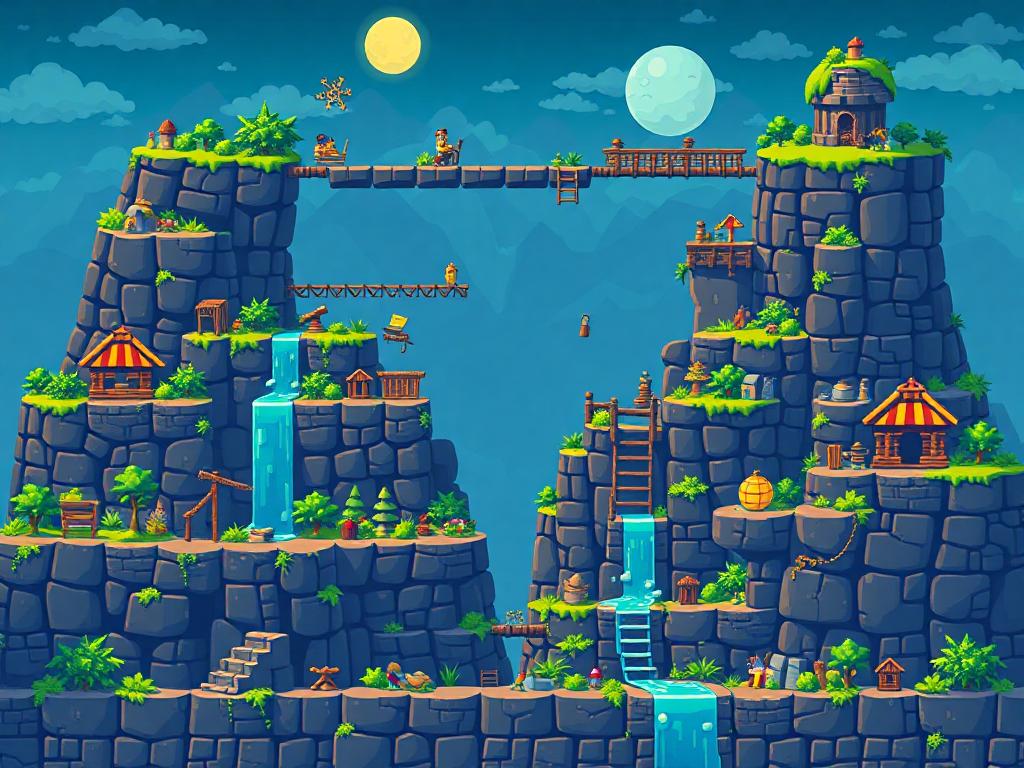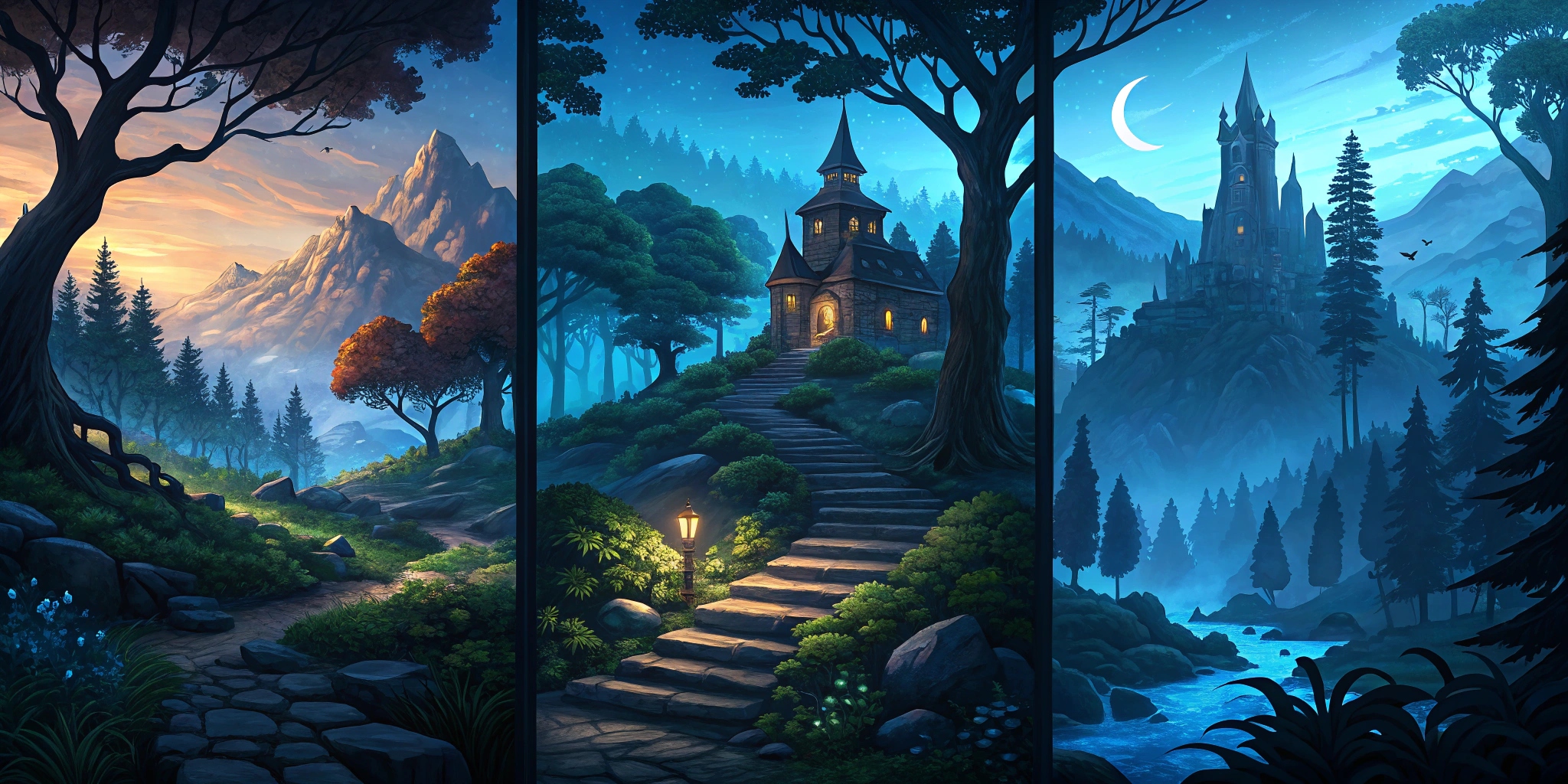Great game level design is a crucial element in creating a successful video game. It can make or break the player’s experience and ultimately determine the success of the game. Level design is not just about creating a visually appealing environment; it is about creating an engaging and immersive time for the player. Good level design should challenge the player and keep them engaged while also advancing the narrative of the game.

To achieve great game level design, it is important to understand the fundamentals of level design. This includes understanding the role of narrative integration in levels, designing for different genres, and creating immersive environments. It is also important to have a solid level design workflow and to use the right tools and technologies to create innovative and engaging levels. Collaboration and communication are also key components of successful level design.
Key Takeaways
- Great game level design is crucial for creating a hit video game.
- Understanding the basics of level design is essential for creating engaging and immersive levels.
- Collaboration, communication, and the use of the right tools and technologies are key components of successful level design.
Fundamentals of Level Design
Level design is a critical aspect of game development that involves creating the surroundings, spaces, and situations that players will interact with in a game. It is responsible for creating a sense of immersion, challenge, and fun for the player. In this section, we will explore the core principles of level design, balancing challenge and fun, and player guidance techniques.
Core Principles
There are several core principles that every level designer should follow to create a successful game level. These include:
- Theme and Atmosphere: A game level should have a consistent theme and atmosphere that matches the overall game’s tone and story.
- Flow and Pacing: The level should have a smooth flow and pacing that allows the player to progress through the level without feeling bored or frustrated.
- Game Mechanics: The level should incorporate the game mechanics in a way that challenges the player and encourages them to use their skills.
- Reward System: A good level should have a reward system that incentivizes the player to complete the level and provides a sense of accomplishment.
Balancing Challenge and Fun
Balancing challenge and fun is essential to creating a successful game level. Too much challenge can make the player feel frustrated, while too little challenge can make the level feel boring. The level designer should create a balance of challenge and fun by:
- Gradual Difficulty Increase: The level should gradually increase in difficulty to challenge the player without overwhelming them.
- Variety of Challenges: The level should have 7a variety of challenges that test different skills and keep the player engaged.
- Feedback System: The level should provide feedback to the player, such as visual or audio cues, to let them know when they are doing well or need to improve.
Player Guidance Techniques
Player guidance techniques are essential to help the player navigate the level and understand what they need to do. The level designer should use the following techniques to guide the player:
- Signposting: The level should use signposting, such as arrows or visual cues, to guide the player through the level.
- Environmental Clues: The level should use environmental clues, such as lighting or objects, to indicate where the player needs to go or what they need to do.
- Tutorials: The level should provide tutorials or instructions to teach the player how to use new game mechanics or complete new challenges.
By following these core principles, balancing challenge and fun, and using player guidance techniques, a level designer can create a successful game level that engages and challenges the player.
Narrative Integration in Levels
Great game levels can tell stories without the need for dialogue or cutscenes. The narrative integration in levels is an essential aspect of game design that adds depth and immersion to the gameplay experience.
Storytelling Through Environment
One way to integrate narrative into levels is through environment storytelling. The game environment can communicate the game’s story, themes, and mood through level design. For example, a post-apocalyptic game can use a desolate and ruined environment to convey a sense of despair and hopelessness.
The game environment can also provide clues and hints about the game’s story and lore. For instance, a game that involves a mystery can use environmental storytelling to leave clues for the player to discover.
Character-Driven Level Design
Another way to integrate narrative into levels is through character-driven level design. This involves designing levels that reflect the character’s personality, goals, and motivations. For example, a game that involves a stealthy character can have levels that require the player to sneak around and avoid detection.
Character-driven level design can also be used to create memorable moments in the game. For instance, a level can be designed to showcase the character’s strengths and abilities, such as a boss fight that requires the player to use all the skills they have acquired throughout the game.
Overall, narrative integration in levels is an essential aspect of game design that can enhance the player’s experience. By using environment storytelling and character-driven level design, game designers can create immersive and engaging gameplay experiences that leave a lasting impression on the player.
Designing for Different Genres
When designing game levels, it’s essential to consider the genre of the game. Different genres require different approaches to level design to create the best experience for the player. Here are some tips for designing levels for different genres.
Puzzle Levels
Puzzle games are all about challenging the player’s intellect. The levels should be designed to be challenging but not frustrating. The goal is to keep the player engaged and motivated to solve the puzzle. To achieve this, the levels should have a clear goal, and the puzzles should be designed around that goal.
One way to design puzzle levels is to use a modular approach. In this approach, the designer creates a set of puzzle pieces that can be combined in different ways to create new puzzles. This approach allows the designer to create a large number of levels without having to create each level from scratch.
Action Game Levels
Action games are all about excitement and adrenaline. The levels should be designed to keep the player engaged and challenged. The levels should have a clear goal, and the challenges should be designed around that goal.
One way to design action game levels is to use a set-piece approach. In this approach, the designer creates a set of set-pieces that can be combined in different ways to create new levels. This approach allows the designer to create a large number of levels without having to create each level from scratch.
Strategy Game Maps
Strategy games are all about planning and tactics. The maps should be designed to allow the player to plan and execute their strategy. The maps should have a clear goal, and the challenges should be designed around that goal.
One way to design strategy game maps is to use a terrain-based approach. In this approach, the designer creates a set of terrains that can be combined in different ways to create new maps. This approach allows the designer to create a large number of maps without having to create each map from scratch.
In conclusion, designing levels for different genres requires different approaches. Puzzle levels require a modular approach, action game levels require a set-piece approach, and strategy game maps require a terrain-based approach. By considering the genre of the game, the designer can create levels that are engaging, challenging, and fun for the player.
Level Design Workflow
Creating a great game level requires a well-defined workflow that takes into account the unique needs of the game and the players. Here are three key steps to follow when designing a game level:
Conceptualization
The first step in the level design workflow is conceptualization. This involves defining the overall vision for the level, including the theme, mood, and setting. The level designer should also consider the game mechanics and how they will be incorporated into the level. This step is crucial as it sets the foundation for the rest of the workflow.
To help conceptualize the level, the designer can create a concept art or mood board that captures the look and feel of the level. This can include sketches, reference images, and color palettes. The designer can also create a design document that outlines the goals, objectives, and challenges of the level.
Prototyping
Once the vision for the level is established, the next step is prototyping. This involves creating a rough draft of the level using a level editor or other prototyping tools. The designer should focus on creating a basic layout of the level, including the placement of obstacles, enemies, and other interactive elements.
During the prototyping phase, the designer can experiment with different ideas and test how they work in the game. This is an iterative process, and the designer should be open to making changes based on feedback from playtesting.
Playtesting and Iteration
The final step in the level design workflow is playtesting and iteration. This involves testing the level with a group of players and gathering feedback on how it can be improved. The designer should observe how the players interact with the level and make note of any issues or areas that need improvement.
Based on the feedback, the designer can make changes to the level and continue to iterate until it is polished and meets the desired level of quality. This step is critical for ensuring that the level is enjoyable and challenging for the players.
By following these three key steps, the level designer can create a well-designed game level that is engaging, challenging, and fun to play.
Creating Immersive Environments
Game level design is not just about creating challenging obstacles and enemies for players to overcome. It’s also about creating immersive environments that transport players to different worlds and engage them emotionally. Here are some tips for creating immersive environments in game level design.
Atmosphere and Mood
Atmosphere and mood are essential elements of game level design that can make or break a player’s experience. The right atmosphere and mood can draw players into the game world and keep them engaged, while the wrong atmosphere and mood can make players feel disconnected and disinterested.
To create the right atmosphere and mood, game designers need to pay attention to every detail, from lighting and sound effects to color schemes and textures. For example, a horror game might use low lighting and eerie sound effects to create a sense of dread and foreboding. A fantasy game, on the other hand, might use bright colors and whimsical music to create a sense of wonder and magic.
Environmental Storytelling
Environmental storytelling is a technique that game designers use to convey information about the game world through the environment itself. Instead of relying on dialogue or cutscenes, environmental storytelling uses visual cues and environmental details to tell a story.
For example, a game set in a post-apocalyptic world might use abandoned buildings and overgrown vegetation to convey a sense of decay and destruction. A game set in a medieval castle might use tapestries and suits of armor to convey a sense of history and grandeur.
By using environmental storytelling, game designers can create a more immersive and engaging experience for players. Instead of simply telling players what’s happening in the game world, they can show them, allowing players to discover the story for themselves.
In summary, creating immersive environments in game level design requires attention to detail and a focus on atmosphere, mood, and environmental storytelling. By following these tips, game designers can create game worlds that draw players in and keep them engaged.
Player Engagement Strategies
Great game level design is all about creating an immersive and engaging experience for the player. To achieve this, designers employ a range of strategies to keep players invested in the game world. Two key strategies are reward systems and dynamic difficulty adjustment.
Reward Systems
Reward systems are a powerful way to keep players engaged in a game. By providing players with incentives to progress, designers can keep them invested in the game and motivated to keep playing. Rewards can take many forms, from in-game currency to power-ups and new abilities.
One effective way to implement a reward system is to offer players a sense of progression. This can be achieved by breaking the game into levels or stages, with each stage offering new challenges and rewards. Another approach is to provide players with a sense of achievement by awarding badges or trophies for completing specific tasks or challenges.
Dynamic Difficulty Adjustment
Dynamic difficulty adjustment is another powerful strategy for keeping players engaged in a game. By adjusting the difficulty of the game in real-time based on the player’s performance, designers can ensure that players are always challenged, but not so much so that they become frustrated and lose interest.
One way to implement dynamic difficulty adjustment is to use an algorithm that adjusts the game’s difficulty based on the player’s skill level. This can be achieved by tracking the player’s performance over time and adjusting the game’s difficulty accordingly. Another approach is to provide players with different difficulty levels to choose from, allowing them to tailor the game to their own skill level.
By employing these strategies, designers can create game levels that are engaging, immersive, and rewarding for players.
Innovative Level Design
Innovative level design can elevate a game from good to great. It involves breaking conventions and creating emergent gameplay that surprises and delights players. Here are two ways to achieve innovative level design.
Breaking Conventions
One way to create innovative level design is by breaking conventions. This means challenging the player’s expectations and introducing new mechanics or gameplay elements. For example, the game Portal subverted the first-person shooter genre by introducing the portal gun, which allowed players to create portals and navigate through levels in a new way. This unexpected gameplay mechanic made the game stand out and created a memorable experience for players.
Another example of breaking conventions is the game Celeste, which is a platformer that deals with mental health. The game’s levels are designed to mirror the protagonist’s emotional journey, with each level representing a different aspect of her struggles. This unconventional approach to level design creates a unique and emotional experience for players.
Emergent Gameplay
Another way to achieve innovative level design is by creating emergent gameplay. Emergent gameplay refers to gameplay that arises from the interaction of game mechanics and player choices, rather than being scripted or pre-planned. This creates a sense of unpredictability and allows players to approach challenges in their own way.
An example of emergent gameplay is the game Hitman, which allows players to approach assassination missions in a variety of ways. Players can choose to go in guns blazing, or they can take a more stealthy approach and disguise themselves as a waiter or security guard. This creates a sense of freedom and allows players to experiment with different strategies.
In conclusion, innovative level design can be achieved by breaking conventions and creating emergent gameplay. By challenging player expectations and allowing for unpredictable gameplay, developers can create memorable and unique gaming experiences.
Tools and Technologies
Game level design is a complex process that requires both creativity and technical skills. To create engaging and immersive game levels, designers use a variety of tools and technologies. In this section, we will discuss some of the most popular tools and technologies used by game level designers.
Level Editors
Level editors are specialized software tools that enable game developers to create and modify game levels. They allow designers to place objects, adjust lighting, and create terrain. Some of the most popular level editors include:
- Unreal Engine Editor: Used by many AAA game studios, Unreal Engine Editor is a powerful and flexible tool that allows designers to create complex game levels with ease. It offers a wide range of features, including a visual scripting system, advanced physics simulation, and support for virtual reality.
- Unity Editor: Unity Editor is a popular game engine that comes with a built-in level editor. It offers a user-friendly interface and a wide range of tools for designing game levels, including terrain tools, lighting tools, and particle systems.
- CryEngine Sandbox: CryEngine Sandbox is a powerful level editor that allows designers to create stunning game levels with advanced features such as real-time global illumination and dynamic weather effects.
Game Engines
Game engines are software frameworks that provide developers with a set of tools and libraries for creating games. They offer a wide range of features, including physics simulation, artificial intelligence, and graphics rendering. Some of the most popular game engines used by game level designers include:
- Unreal Engine: Developed by Epic Games, Unreal Engine is one of the most popular game engines in the industry. It offers a wide range of features, including advanced physics simulation, dynamic lighting, and support for virtual reality.
- Unity: Unity is a popular game engine that offers a wide range of tools for creating games. It comes with a built-in level editor and supports a wide range of platforms, including mobile devices and consoles.
- CryEngine: Developed by Crytek, CryEngine is a powerful game engine that offers advanced features such as real-time global illumination and dynamic weather effects. It is used by many AAA game studios to create stunning game levels.
In conclusion, game level design is a complex process that requires both creativity and technical skills. To create engaging and immersive game levels, designers use a variety of tools and technologies, including level editors and game engines. By leveraging these tools, designers can create stunning game levels that captivate players and keep them coming back for more.
Collaboration and Communication
Great game level design involves collaboration and communication between interdisciplinary teams. A level designer must work closely with artists, programmers, and other team members to ensure that the level is designed to meet the game’s requirements. Effective communication is essential to ensure that everyone is on the same page and working towards the same goals.
Interdisciplinary Team Dynamics
Interdisciplinary team dynamics play a critical role in game level design. A successful team must have a clear understanding of each other’s roles and responsibilities. Each team member must be able to communicate their ideas and feedback effectively. A level designer must be able to work with artists to ensure that the level’s aesthetics are consistent with the game’s overall design. Similarly, they must work with programmers to ensure that the level’s mechanics are implemented correctly.
Effective Feedback Loops
Effective feedback loops are essential to ensure that the game level design meets the game’s requirements. A level designer must be able to provide feedback to artists and programmers to ensure that the level meets the game’s objectives. Similarly, artists and programmers must be able to provide feedback to the level designer to ensure that the level’s aesthetics and mechanics are consistent with the game’s overall design.
To facilitate effective feedback loops, a level designer must be able to provide clear and concise feedback. They must be able to identify issues and provide specific recommendations for improvement. Similarly, artists and programmers must be able to provide constructive feedback that is actionable and specific.
In conclusion, collaboration and communication are critical to great game level design. Effective interdisciplinary team dynamics and feedback loops are essential to ensure that the level meets the game’s requirements. A level designer must work closely with artists, programmers, and other team members to ensure that the level is designed to meet the game’s objectives.
Future of Level Design
As technology advances, the future of level design is constantly evolving. Here are two areas that are likely to have a significant impact on the future of level design:
Virtual Reality Challenges
Virtual reality (VR) is becoming increasingly popular, and it presents unique challenges for level designers. In VR, players have a greater sense of immersion and presence, which means that level designers need to create environments that feel more realistic and believable. This can be challenging, as designers need to consider the player’s physical movements and interactions with the environment.
In addition, VR presents new challenges in terms of motion sickness. Players can experience nausea and discomfort if the level design does not take into account the player’s movement and orientation in the virtual world. Designers need to be aware of these challenges and create environments that minimize the risk of motion sickness.
Procedural Generation
Procedural generation is a technique used to create game content dynamically, rather than designing it by hand. This technique can be used to create vast, open worlds with a high degree of variation. Procedural generation can also be used to create levels that are unique to each player, providing a more personalized experience.
However, procedural generation also presents challenges for level designers. Designers need to create algorithms that can generate content that is both interesting and challenging, while still maintaining a sense of coherence and consistency. They also need to consider how players will interact with the generated content and ensure that it is balanced and fair.
Overall, the future of level design is exciting and full of possibilities. As technology continues to advance, designers will need to adapt and evolve to create new and innovative experiences for players.
Frequently Asked Questions
What are the core principles of effective level design in video games?
Effective level design is the foundation of a great gaming experience. The core principles of effective level design include a clear sense of progression, a balance between challenge and reward, and a well-defined sense of space. Levels should be designed in a way that encourages exploration and discovery while also providing clear objectives for the player to achieve.
How does level design contribute to a player’s overall gaming experience?
Level design plays a critical role in shaping a player’s overall gaming experience. Well-designed levels can create a sense of immersion, challenge, and excitement that keeps players engaged and invested in the game. Levels can also help to establish the game’s world and lore, providing context and depth to the player’s experience.
What are the key differences in level design between different game genres, such as FPS and adventure games?
Different game genres require different approaches to level design. FPS games, for example, often require levels that are designed to facilitate fast-paced action and combat. Adventure games, on the other hand, may require more open-ended levels that encourage exploration and puzzle-solving. The key is to design levels that are tailored to the specific needs and requirements of the game’s genre.
What strategies are used to create engaging multiplayer levels?
Creating engaging multiplayer levels requires a deep understanding of the game’s mechanics and player dynamics. Levels should be designed in a way that encourages teamwork, strategy, and competition. Multiplayer levels should also be balanced to ensure that no one player or team has an unfair advantage.
How can level design influence the difficulty and pacing of a game?
Level design plays a critical role in shaping the difficulty and pacing of a game. Levels should be designed in a way that gradually increases the difficulty as the player progresses, providing a sense of challenge and reward. Levels can also be designed to create moments of tension and excitement, helping to build suspense and anticipation.
What are some examples of games with exemplary level design, and what can we learn from them?
There are many games with exemplary level design, including classics like Super Mario Bros., Half-Life 2, and Portal. These games all feature levels that are designed to be challenging, engaging, and rewarding. They also demonstrate the importance of creating levels that are tailored to the specific needs and requirements of the game’s genre. By studying these games, designers can learn valuable lessons about effective level design and apply them to their own work.










